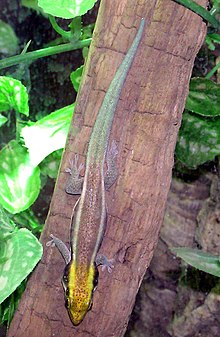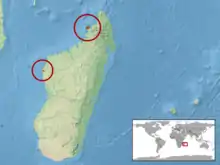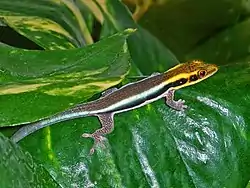Yellow-headed day gecko
The yellow-headed day gecko (Phelsuma klemmeri), also commonly called Klemmer's day gecko,[2] or the cheerful day gecko, is a small diurnal species of gecko, a lizard in the family Gekkonidae. This endangered species is endemic to northwestern Madagascar and inhabits coastal forests (both dry and humid), dwelling on bamboo.[1] The yellow-headed day gecko feeds on insects and nectar.
| Yellow-headed day gecko | |
|---|---|
 | |
| Scientific classification | |
| Kingdom: | Animalia |
| Phylum: | Chordata |
| Class: | Reptilia |
| Order: | Squamata |
| Family: | Gekkonidae |
| Genus: | Phelsuma |
| Species: | P. klemmeri |
| Binomial name | |
| Phelsuma klemmeri Seipp, 1991 | |
 | |
Etymology
The specific name, klemmeri, is in honor of German herpetologist Konrad Klemmer.[2]
Geographic range
P. klemmeri inhabits northwest Madagascar, along the coast. It is only known from the Ampasindava Peninsula (at Antsatsaka) and near Mandrozo Lake.[1]
Habitat

P. klemmeri typically lives in bamboo forests. It sometimes shares its habitat with Phelsuma seippi and Phelsuma madagascariensis grandis. P. klemmeri is found only on yellow bamboo canes, which they also use to hide in case of danger.
Description
P. klemmeri can reach a total length (including tail) of about 4 inches (10 cm). The body colour of this slender and long-snouted gecko is turquoise blue at the upper and mid-back. The lower back is light brown. Most of the tail is turquoise blue. Remarkable is the laterally flattened body. Another typical characteristic is the yellow head. A dark black spot is present behind the eye, followed by a black stripe which extends to the rear extremities. The legs and toes are brown speckled. The ventral side is grayish white. The sexes can easily be distinguished by the orange color around the femoral pores of the males.
Diet
P. klemmeri feeds on various insects and other invertebrates. It also likes to lick soft sweet fruit, pollen, and nectar.
Behaviour
P. klemmeri likes to bask. It often lives in small groups.
Reproduction
The female P. klemmeri lays a pair of eggs and hides them in bamboo canes. At a temperature of 27 °C (80.6 °F), the young will hatch after approximately 39–52 days. Each juvenile measures 22–29 mm (0.87–1.14 in).
Captivity
The species P. klemmeri is bred extensively in captivity, and the IUCN thinks it unlikely that it is still wild-caught.[1]
References
| Wikispecies has information related to Yellow-headed day gecko. |
| Wikimedia Commons has media related to Phelsuma klemmeri. |
- Raxworthy CJ et al. (2011). "Phelsuma klemmeri ". IUCN Red List of Threatened Species – Version 2012.2. International Union for Conservation of Nature. Downloaded on 31 May 2013.
- Beolens, Bo; Watkins, Michael; Grayson, Michael (2011). The Eponym Dictionary of Reptiles. Baltimore: Johns Hopkins University Press. xiii + 296 pp. ISBN 978-1-4214-0135-5. (Phelsuma klemmeri, p. 143).
Further reading
- Glaw F, Vences M (1994). A Fieldguide to the Amphibians and Reptiles of Madagascar, Second Edition. Cologne, Germany: Vences & Glaw Verlag / Serpents Tale. 480 pp. ISBN 978-3929449-01-3.
- Henkel F-W; Schmidt W (1995). Amphibien und Reptilien Madagaskars, der Maskarenen, Seychellen und Komoren. Stuttgart: Ulmer. ISBN 3-8001-7323-9. (in German).
- McKeown, Sean (1993). The general care and maintenance of day geckos. Lakeside, California: Advanced Vivarium Systems.
- Seipp R (1991). "Eine neue Art der Gattung Phelsuma Gray 1825 von Madagaskar (Reptilia: Sauria: Gekkonidae)". Senckenbergiana Biologica 71: 11–14. (Phelsuma klemmeri, new species). (in German).
